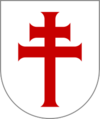Ordo Canonicorum Regularium Custodum Sacrosant Sepulchri Domini Hierosolymitani | |
 Coat of arms of the Canons Regular of the Holy Sepulchre | |
| Formation | 1113 (1099) |
|---|---|
| Founded at | Church of the Holy Sepulchre Jerusalem, Kingdom of Jerusalem |
| Dissolved | 1830 |
| Type | Canons Regular |
| Purpose | Protection of the Church of the Holy Sepulchre |
| Location | |
| Methods | Rule of Saint Augustine |
Parent organization | Catholic Church |
| Secessions | Canonesses of the Holy Sepulchre (c. 1300) |
The Canons Regular of the Holy Sepulchre were a Catholic religious order of canons regular of the Rule of Saint Augustine, said to have been founded in the Church of the Holy Sepulchre in Jerusalem, then the capital of the Kingdom of Jerusalem, and recognised in 1113 by a Papal bull of Pope Paschal II. Other accounts have it that they were founded earlier, during the rule of Godfrey of Bouillon (1099–1100).
After the fall of Jerusalem to Saladin, the Canons fled the Holy Land along with other Latin Christians. They first settled briefly on Cyprus, where they established Bellapais Abbey, before proceeding to settle in various countries of Europe.
The Canons Regular of the Holy Sepulchre was suppressed in 1489 by Pope Innocent VIII (1484–1492). On March 28, 1489, the pope, at the instigation of the Order of Malta, issued a bull[1] by which the Order of Canons Regular of the Holy Sepulchre was to be dissolved and transferred to the Order of Malta. However, the independence of the Order of Canons Regular of the Holy Sepulchre was maintained at the request of Emperor Maximilian and Duke Eberhard of Württemberg and confirmed in 1499 with a bull of Pope Alexander VI (1492–1503).[2]
Because of this, the male branch of the Order of Canons Regular of the Holy Sepulchre existed in Europe until the 19th century, with many branches in Spain, Germany, and Poland. Tomasz de Nowina Novinski, last General of the Order[3] and Auxiliary Bishop of Kraków (1816–1830)[4] died on 4 January 1830 in Miechów (Poland).
The Canonesses Regular of the Holy Sepulchre, founded in the 14th century as a female branch of the Canons Regular of the Holy Sepulchre,[5] still exist in convents in Belgium, the Netherlands, France, Spain, and England.
- ^ J. Hermens, Der Orden vom Heil. Grabe, II Auflage. Druck: L. Schwannsche Verlagshandlung, Köln und Neuss, 1870. Bulle Innocenz´ VIII vom 28. März 1489, Seiten 97 bis 101.
- ^ Herrmann, Wilhelm (1938). "Zur Geschichte der Neisser Kreuzherren vom Orden der regulierten Chorherren und Wächter des Heiligen Grabes zu Jerusalem mit dem doppelten roten Kreuz" (in German). Retrieved 2017-05-17.
- ^ "Order Miechowski i generał Dąbrowski". 24 December 2005.
- ^ "Erzbischof von Krakau".
- ^ "Our Association Worldwide". Canonesses Regular of the Holy Sepulchre. Archived from the original on February 17, 2013. Retrieved 18 September 2016.